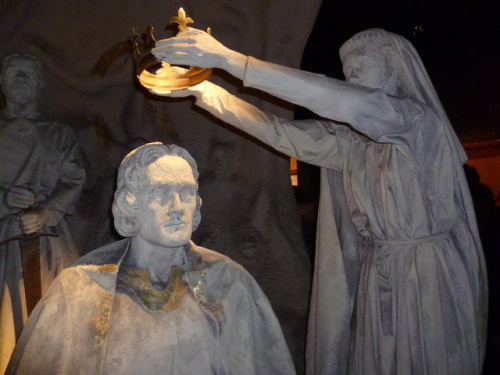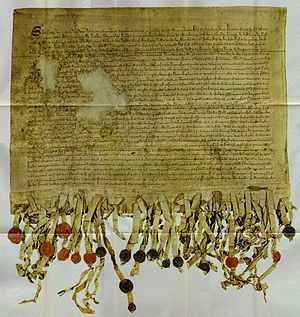peashooter85:Robert the Bruce Part VI —- King of Scots ForeverAfter the Battle of Bannockburn, every
peashooter85:Robert the Bruce Part VI —- King of Scots ForeverAfter the Battle of Bannockburn, everything started to go right for Robert the Bruce. He kept up the pressure on the English by conducting more raids in England. He even invaded Ireland to remove English rule from the island. Incredibly because of this, he was named by the Irish High King of Ireland (peashooter didn’t know this!). Now that his queen was freed from the English, the Bruce also got down to the business of building a family, and thus building a dynasty. It seemed like a matter of time before Edward II would have no choice but to recognize Scotland’s sovereignty. However Edward II had one powerful influence who could undermine everything the Bruce had worked for… God (through the power of the Pope). Incredibly Edward II was able to convince the Pope to issue a number of Papal Bulls which invalidated all Scottish claims to independence. The Pope decreed that King Edward II was the only legitimate rule of Scotland, that it was Scotland’s fault for the war, and renewed Robert the Bruce’s excommunication. While today it seems unthinkable for the Pope to order around nations, in the Middle Ages people were extremely religious, and the Pope was looked upon as the literal human voice of God. The Pope’s decrees may have well have been commandants from the Big Man Himself.The Papal decrees devastated the Bruce. As an excommunicated man he was doomed to an eternity in Hell after death. Those who followed him were doomed to the same. Those who traded or made diplomatic relations with Scotland were also scorned by God. In 1320 a group of Scottish clergy and lawyers presented a document to the Pope called the “Declaration of Abroath”. They argued that it was England’s fault for the war, outlined the history of English atrocities, defended the Bruce’s claim to the throne, and asserted the popular sovereignty of the Scottish People. Furthermore, they made the bargain that if the Pope annulled his earlier decrees, the Scots would go on crusade for the Church. Regardless of their arguments and offers, the Pope refused to recognize the Declaration of Abroath.To further destabilize Scotland, Edward II ordered every church within the Kingdom of England to curse Robert the Bruce twice daily, before and after Holy Mass. In the meantime the Bruce was growing older and his health was declining. He even contracted leprosy, a terrible disease which caused him terrible pain, weakened his muscles, and disfigured his face. To the Bruce, this was a signal that the curses were working, and that he was disfavored by God. It seemed as though Scotland would be damned forever, but in 1327 something unexpected happened. England fell into civil war and King Edward II was overthrown and replaced by his son Edward III. In the chaos and confusion of the civil war the Bruce saw one last opportunity to bid for Scottish independence. Building a large army, he invaded England. Due to the weakened state of England, King Edward III had no other option to recognize the Bruce’s rule and Scottish Independence. In 1328 the Treaty of Edinburgh-Northamptom was signed, in which England official recognized Scottish sovereignty. Due to the treaty, the Pope was also convinced to recognize Scottish independence. He anulled all previous Bulls issued against Scotland, and revoked the Bruce’s excommunication.During the last year of his life, the Bruce spent his time trying to get right with Jesus. During “The Harrying of North” and similar massacres, the Bruce had ordered to slaughter of many innocent Scots in an almost genocidal mania. To atone for his sins, the Bruce financed crusades, traveled on several holy pilgrimages, sponsored the building of abbeys, monasteries, and cathedrals all over Scotland, and practiced penance rituals. Such rituals involved lying on the cold floor naked while praying for forgiveness, fasting for weeks on end, and self flagellation. He also hired several hundred monks to pray for his soul continuously until his death. Robert the Bruce died of leprosy on June 7th, 1329. After his death, his five year old son David II was crown King of Scots. The English would invade Scotland 3 years later, sparking the 2nd War of Scottish Independence. So much for Papal Bulls and English Treaties. After his death Robert the Bruce’s heart was removed and taken on a Scottish crusade to Spain in order to fight the Moors. After the crusade, the heart was returned to Scotland. Today Robert the Bruce is one of the most popular figures in Scottish history, whose story has gone from history, to larger than life legend. -- source link


